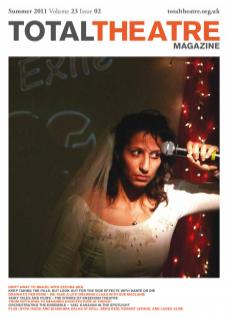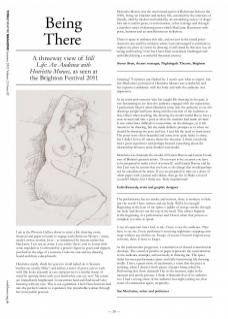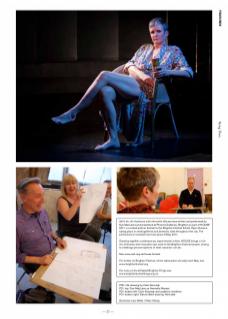I am at the Phoenix Gallery about to enter a life-drawing room, charcoal and paper in hand, to engage with Henrietta Moraes – muse, model, writer, mother, lover – as interpreted by theatre-maker Sue MacLaine. I am not an artist, I very rarely ‘draw’, and so I enter with some trepidation. Confronted by a pensive figure in gown and slippers, perched on the edge of a rostrum, I take my seat and my drawing board and draw a deep breath.
Henrietta stands, sheds her gown to stand naked on it (because ‘studios are usually filthy’) and strikes a series of poses, one to each wall. She looks instantly at ease and puts me in a similar frame of mind by quoting ‘draw with your hand what your eye sees’. My senses are immediately heightened. I concentrate hard and find myself also listening with my eyes. This is not a gimmick. I feel I have been invited into the perfect context to experience this remarkable woman through her most public persona.
Henrietta Moraes was the uncrowned queen of Bohemian Soho in the 1950s, living ‘an itinerant and rackety life, sustained by the tolerance of friends, oiled by alcohol and fuelled by an astonishing variety of drugs’. Her tale is told in prose, in conversation, in her writings and through a seamless series of drawing-poses which MacLaine illuminates with poise, humour and an unselfconscious reflection.
There is space to embrace this tale, and not just in the timed poses (between one and five minutes) where I am encouraged to continue to explore my place as viewer by drawing. Confronted by this new way of ‘seeing and hearing’ I tire but I have been nourished, challenged and enthralled during a wonderful theatrical journey.
Steven Brett, theatre manager, Nightingale Theatre, Brighton
Amazing! 75 minutes just flashed by. I wasn’t sure what to expect, but Sue MacLaine’s portrayal of Henrietta Moraes was wonderful, and her supreme confidence with her body and with the audience was impressive.
As an artist and someone who has taught life-drawing in the past, it was fascinating to see how the audience engaged with the experience. I particularly liked it when Henrietta came into the audience to see the drawings people had been doing and the reaction of the audience to this. Often when teaching life-drawing the model would like to have a nose around and take a peek at what the students had made of them. It was sometimes difficult to concentrate on the dialogue, as it felt natural to be drawing, but she made definite prompts as to when we should be drawing the pose and not. I just felt the need to draw more. The poses were often beautiful and some were quite tricky to draw, but I didn’t feel at all uneasy about the situation. I think everybody had a great experience and perhaps learned something about the relationship between artist/student and model.
Henrietta was famously the model of Francis Bacon and Lucian Freud, two of Britain’s greatest artists. ‘If you want to be an artist you have to be prepared to make a fool of yourself,’ said Francis Bacon, and by this I am sure he meant that you have to do things that would perhaps not be considered the norm. If you are prepared to take on a sheet of white paper with a pencil and rubber, then go for it! Make a fool of yourself? Maybe, but I think not. Truly inspirational!
Colin Kennedy, artist and graphic designer
The performance has no smoke and mirrors, there is nowhere to hide: just the words I have written and my body. Will it be enough? Beginning in the base of my spine: a judder of energy streaks through my body and shoots out the top of my head. This always happens at the beginning of a performance and I know when that process is complete it is time to speak.
A sea of expectant faces look at me. I have to see the audience. They have to see me. Every performer’s recurring nightmare: stepping onto stage without any clothes on. Except of course I haven’t forgotten my costume, there is none to forget.
As the performance progresses, a communion of shared concentration develops. The sound of pencils on paper represents the concentration as the audience attempts, and succeeds, in drawing me. The space shifts between performance space and fully functioning life drawing studio. I have a great sense of excitement, a sense that the piece is working, when I observe fresh pieces of paper being asked for. Performing this show demands I be in the moment, right in the moment and utterly present. I think it demands that of its audience too. I had a strong sense of the audience last night joining me, that sense of communion again, reciprocity.
Sue MacLaine, writer and performer
Still Life: An Audience with Henrietta Moraes was written and performed by Sue MacLaine and presented at Phoenix Galleries, Brighton as part of HOUSE 2011, a curated partner festival to the Brighton Festival Artists Open Houses, taking place in small galleries and domestic sites throughout the city. The performance reviewed here took place 9 May 2011.
Drawing together contemporary, experimental artists, HOUSE brings a rich mix of diverse and innovative new work to the Brighton Festival season, aiming to challenge preconceptions of what visual art can be.
See www.aoh.org.uk/house-festival
For further on Brighton Festival, which takes place annually each May, see www.brightonfestival.org
For more on the affiliated Brighton Fringe see www.brightonfestivalfringe.org.uk


